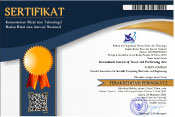(2) Rustopo Rustopo
(3) Bambang Sunarto
*corresponding author
AbstractThis article examines the problem of the literary composition of Laksita Jati music as a script for the final assignment of postgraduate students in the art creation program of the Institut Seni Indonesia (ISI) Surakarta. The focus of the study is centered on whether the final project text is part of the aesthetic practices of the co-operative aesthetic or adds weight to the music created? As intellectual property, the manuscript is one of the graduation conditions whose values are parallel to the work itself. With such importance, ideally, the music creation script should be able to describe the entire process until its production is comprehensive. In other words, this art creation script must be able to reflect the quality or weight of the work presented. However, if judging from the standardized system and format of writing, the text may be a fetter of creativity (cooperative regime) for creators who have a personal aesthetic orientation and vision. The assumption is that by referring to a systematic writing format often traps the writer to get absorbed in formalistic writing rules rather than writing the substance of his work itself. The author, in this case, is more concerned with the structure of writing than on content. Another argument is that if we look at the contents of the script, which is a reflection of overall performance, it is not impossible to be used to see the quality of music that students create. This study uses Bartes' synchronous and semiotic acceptance method, "Death of the author." to analyze and overcome the problems in this study. The result, besides showing how the values (taksu) of Laksita Jati music, also revealed the existence of a little aesthetic regime practices in writing scripts for the creation of art.
KeywordsManuscript of Artistic Creation; Art Literacy; Aesthetic Regimes; Taksu; Intellectual-Property
|
DOIhttps://doi.org/10.31763/viperarts.v2i1.131 |
Article metrics10.31763/viperarts.v2i1.131 Abstract views : 2695 | PDF views : 940 |
Cite |
Full Text Download Download
|
References
F. Burrack, “Enhanced Assessment in Instrumental Programs,†Music Educ. J., vol. 88, no. 6, p. 27, May 2002, doi: 10.2307/3399802.
A. Gabrielsson, “The Performance of Music,†in The Psychology of Music, Elsevier, 1999, pp. 501–602.
J. L. Castejon, A. M. Perez, and R. Gilar, “Confirmatory factor analysis of Project Spectrum activities. A second-order g factor or multiple intelligences?,†Intelligence, vol. 38, no. 5, pp. 481–496, Sep. 2010, doi: 10.1016/j.intell.2010.07.002.
B. A. Almond and R. DeJordy, “Institutionalization in cultural industries: The reciprocal influence of commercial recordings and social practices in the evolution of traditional Irish music,†J. Enterprising Communities People Places Glob. Econ., vol. 6, no. 4, pp. 304–324, Oct. 2012, doi: 10.1108/17506201211272751.
Wang, “Losing Self: The Application of Zhuangzian Wuwei and Balinese Taksu to the Development of Musicianship,†Philos. Music Educ. Rev., vol. 27, no. 2, p. 133, 2019, doi: 10.2979/philmusieducrevi.27.2.03.
B. Wiryomartono, “Dwelling as Dharma: A Hindu–Balinese Experience of Building and Living in Modernity,†in Perspectives on Traditional Settlements and Communities, Singapore: Springer Singapore, 2014, pp. 69–89.
B. Christensen, “Warp, Weft, and Waffle: Weaving Information Literacy into an Undergraduate Music Curriculum,†Notes, vol. 60, no. 3, pp. 616–631, 2004, doi: 10.1353/not.2004.0005.
K. A. Abromeit and V. Vaughan, “Info Lit and the Diva: Integrating Information Literacy into the Oberlin Conservatory of Music Opera Theater Department,†Notes, vol. 60, no. 3, pp. 632–652, 2004, doi: 10.1353/not.2004.0001.
Waller, “Language Literacy and Music Literacy: A Pedagogical Asymmetry,†Philos. Music Educ. Rev., vol. 18, no. 1, p. 26, 2010, doi: 10.2979/pme.2010.18.1.26.
Y. Sui and M. Fan, “Reinterpreting some key concepts in Barthes theory,†J. Media Commun. Stud., vol. 7, no. 3, pp. 59–66, Mar. 2015, doi: 10.5897/JMCS2014.0412.
C. A. Martindale and L. Hardwick, “Reception,†in Oxford Research Encyclopedia of Classics, Oxford University Press, 2015.
B. H. Smith, “What Was ‘Close Reading’?: A Century of Method in Literary Studies,†minnesota Rev., vol. 2016, no. 87, pp. 57–75, Oct. 2016, doi: 10.1215/00265667-3630844.
J. D. Culler, “Barthes, Theorist,†Yale J. Crit., vol. 14, no. 2, pp. 439–446, 2001, doi: 10.1353/yale.2001.0022.
J. Jeongwon and H. Song, “Roland Barthes’ ‘Text’ and aleatoric music: Is ‘The birth of the reader’ the birth of the listener?,†Muzikologija, no. 2, pp. 263–281, 2002, doi: 10.2298/MUZ0202263J.
J. P. Sharp, “Writing Travel/Travelling Writing: Roland Barthes Detours the Orient,†Environ. Plan. D Soc. Sp., vol. 20, no. 2, pp. 155–166, Apr. 2002, doi: 10.1068/d220t.
C. Belsey, “The death of the reader,†Textual Pract., vol. 23, no. 2, pp. 201–214, Apr. 2009, doi: 10.1080/09502360902760224.
H. de Burghâ€Woodman and J. Braceâ€Govan, “Jargon as imagining: Barthes’ semiotics and excavating subcultural communication,†Qual. Mark. Res. An Int. J., vol. 11, no. 1, pp. 89–106, Jan. 2008, doi: 10.1108/13522750810845577.
P. Dunbar-Hall, “Culture, Tourism and Cultural Tourism: Boundaries and frontiers in performances of Balinese music and dance,†J. Intercult. Stud., vol. 22, no. 2, pp. 173–187, Aug. 2001, doi: 10.1080/07256860120069594.
D. Fancy, “Difference, bodies, desire: The collaborative thought of Gilles Deleuze and Félix Guattari,†Sci. Fict. Film Telev., vol. 3, no. 1, pp. 93–106, Jan. 2010, doi: 10.3828/sfftv.2010.6.
D. Pollock and J. R. Cox, “Historicizing ‘reason’: Critical theory, practice, and postmodernity,†Commun. Monogr., vol. 58, no. 2, pp. 170–178, Jun. 1991, doi: 10.1080/03637759109376221.
M. I. Franklin, “Reading Walter Benjamin and Donna Haraway in the age of digital reproduction,†Information, Commun. Soc., vol. 5, no. 4, pp. 591–624, Jan. 2002, doi: 10.1080/13691180208538808.
Refbacks
- There are currently no refbacks.
Copyright (c) 2020 Joko Suranto, Rustopo Rustopo, Bambang Sunarto

This work is licensed under a Creative Commons Attribution-ShareAlike 4.0 International License.
___________________________________________________________
International Journal of Visual and Performing Arts
ISSN 2684-9259
Published by Association for Scientific Computing Electronics and Engineering (ASCEE)
W: http://pubs2.ascee.org/index.php/viperarts
E: sularso@ascee.org
Organized by:
 This work is licensed under a Creative Commons Attribution-ShareAlike 4.0
This work is licensed under a Creative Commons Attribution-ShareAlike 4.0
























